 Download PDF
Download PDF
Name: Convolvulus arvensis L.
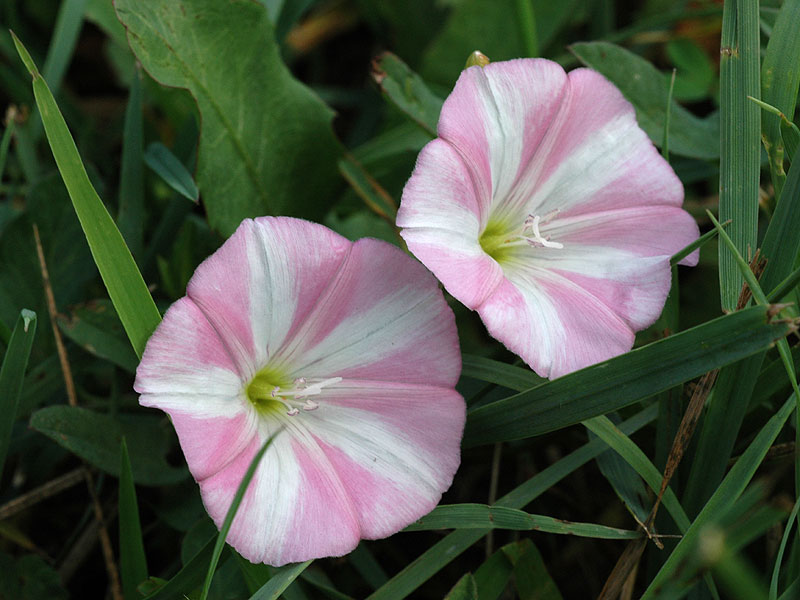 Family: Convolvulaceae, the Bindweed or Morning Glory Family
Family: Convolvulaceae, the Bindweed or Morning Glory Family
Common Names: field bindweed, creeping Jenny, European bindweed, morning glory, perennial morning glory, small-flowered morning glory, creeping Charlie, field morning glory, devil’s guts, orchard morning glory, possession vine, and corn bind, to name a few (1,2,3). According to Austin (4), C. arvensis “has at least 84 common names”.
Etymology: Convolvulus comes from the Latin convolv, which means ‘rolling together’ or ‘twining’. Arvensis is the Latin world for ‘field’ (13).
Botanical synonyms: Convolvulus ambigens House, Convolvulus incanus auct. non Vahl, Strophocaulos arvensis (L.) Small (1).
Quick Notable Features:
¬ slim, 4- or 5-angled stems that sprawl or twine
¬ broad, open rotate corolla (typical morning glory form) with yellow or orange fused nectaries
Plant Height: When not climbing, C. arvensis can form thick mats up to 5cm off the ground. The stems grow to 2m in length (3).
Subspecies/varieties recognized (17):
Convolvulus arvensis var. angustatus Ledeb.
Convolvulus arvensis var. crassifolius Choisy
Convolvulus arvensis var. hastulatus Meisn.
Convolvulus arvensis var. linearifolius Choisy
Convolvulus arvensis var. sagittaefolius Turcz.
Convolvulus arvensis var. sagittatus Ledeb.
Convolvulus arvensis var. sagittifolius Turcz.
Convolvulus arvensis var. villosus Choisy
Most Likely Confused with: Ipomoea spp., Calystegia spp., Dioscorea spp.
Habitat Preference: C. arvensis establishes itself in any slightly disturbed habitat, including but not limited to fields, railroads, garden edges, fencerows, and roadsides. It prefers open, sunny areas, but can establish in forests with a moderate canopy. In general, the roots are tolerant of frost but not standing water (5,10).
Geographic Distribution in Michigan: Within Michigan, C. arvensis is randomly distributed, growing in approximately 60% of Michigan’s counties with no clear indication of habitat preference (1). It was introduced to Michigan in approximately 1890 (4).
Known Elevational Distribution: Found up to 3000m in the Himalayas (3).
Complete Geographic Distribution: Native to the Mediterranean, C. arvensis was introduced to the New World for ornamental and medicinal purposes in the 1730s, and has since spread to every state except Alaska, as well as every Canadian province bordering the United States (1,4).
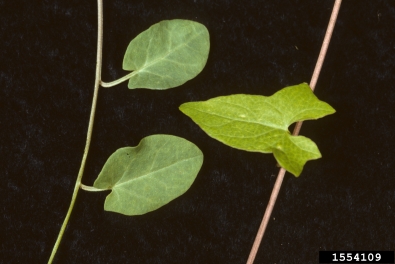 Vegetative Plant Description: C. arvensis is an herbaceous perennial with glabrous or pubescent stems that appear 4- or 5-angled due to their twining, growing up to 2m in length. The opposite, simple, sometimes pubescent leaves are borne on slender, glabrous or pubescent petioles that are +3 cm in length; leaves hastate or sagittate, 1-10 cm long and 0.25 – 6 cm in width. Venation is arcuate-pinnate. The plant produces deep, perenniating taproots with many annual lateral roots that spread radially and act as a method of vegetative reproduction via root buds (3,7,8,19).
Vegetative Plant Description: C. arvensis is an herbaceous perennial with glabrous or pubescent stems that appear 4- or 5-angled due to their twining, growing up to 2m in length. The opposite, simple, sometimes pubescent leaves are borne on slender, glabrous or pubescent petioles that are +3 cm in length; leaves hastate or sagittate, 1-10 cm long and 0.25 – 6 cm in width. Venation is arcuate-pinnate. The plant produces deep, perenniating taproots with many annual lateral roots that spread radially and act as a method of vegetative reproduction via root buds (3,7,8,19).
Climbing Mechanism: The species twines apically, and stems twist from right to left (dextrally). It is reported that C. arvensis loses its prostrate form and begins to twine in shady habitat (5,6).
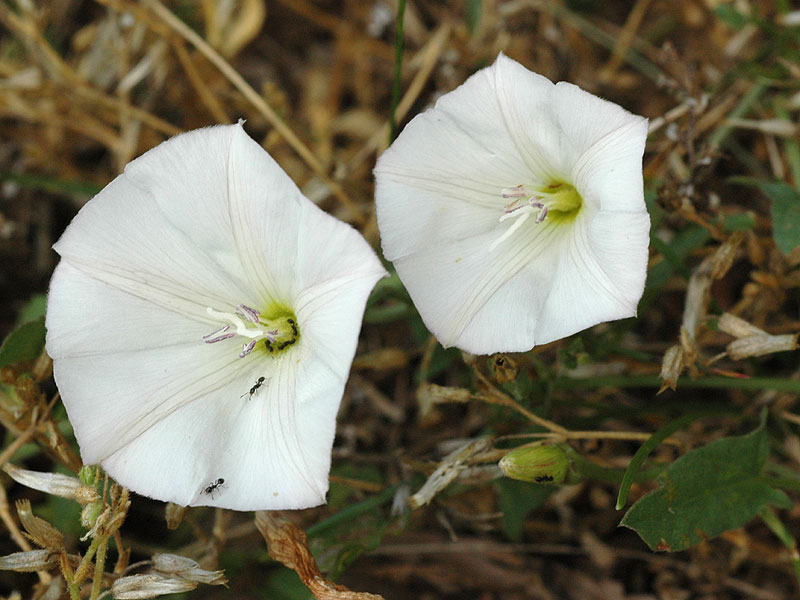 Flower Description: The white, pink, or rarely red flowers can be solitary or in cymes of 2-3 flowers. Each inflorescence is borne on a peduncle up to 6cm in length that grows from the leaf axil, and the peduncle bears a pair of opposite bracts subtending the pedicels. These bracts are linear, glabrous to tomentose, and ca. 4mm long. A similar pair of opposite bracts grows at the middle of the ~2cm long pedicel. The 5-merous flower has green, glabrous, fused sepals that are up to 4mm long and 2.1mm wide. The fused petals are approximately 3cm wide and 2cm long and sometimes slightly pubescent. Five stamens are adnate to the base of the corolla tube, their filaments flattened at the base and rounded at the top, about 1cm long. The anthers are whitish pink, about 3mm long. The white, 2-locular ovary is glabrous to pubescent and 2mm long with a white style, up to 1cm long, with two yellowish stigmas up to 4mm long. The ovary is surrounded by an orange or yellow ring of nectar (3,4,5,6,7,8).
Flower Description: The white, pink, or rarely red flowers can be solitary or in cymes of 2-3 flowers. Each inflorescence is borne on a peduncle up to 6cm in length that grows from the leaf axil, and the peduncle bears a pair of opposite bracts subtending the pedicels. These bracts are linear, glabrous to tomentose, and ca. 4mm long. A similar pair of opposite bracts grows at the middle of the ~2cm long pedicel. The 5-merous flower has green, glabrous, fused sepals that are up to 4mm long and 2.1mm wide. The fused petals are approximately 3cm wide and 2cm long and sometimes slightly pubescent. Five stamens are adnate to the base of the corolla tube, their filaments flattened at the base and rounded at the top, about 1cm long. The anthers are whitish pink, about 3mm long. The white, 2-locular ovary is glabrous to pubescent and 2mm long with a white style, up to 1cm long, with two yellowish stigmas up to 4mm long. The ovary is surrounded by an orange or yellow ring of nectar (3,4,5,6,7,8).
Flowering Time: C. arvensis flowers from May to September in Illinois and Missouri (3,7,8).
Pollinator: Insect-pollinated. It is noteworthy that C. arvensis is self-incompatible, requiring pollinators (9).
 Fruit Type and Description: A glabrous, 4-valved capsule, ca. 6mm long and dehiscent (7,8).
Fruit Type and Description: A glabrous, 4-valved capsule, ca. 6mm long and dehiscent (7,8).
Seed Description: A dark brown or black sub-ovate seed that can remain viable for a minimum of 20 years, and up to 50 years. Up to 500 seeds are produced per plant (5,10).
Dispersal Syndrome: Capsule dehisces. It is also eaten by animals or transferred via farm equipment. Long-range dispersal has been attributed to birds, where seeds can remain viable after having been in the stomachs of some species for more than six days. The stems are sometimes found contaminating fodder (10).
Distinguished by: Ipomoea and Convolvulus are very difficult to differentiate at a morphological level. One consistent difference seems to be in style form: that of Ipomoea is small and capitate, with 1-3 lobes. The style of Convolvulus is linear to oblong and there are always 2 lobes. Another (less reliable) difference is that the sepals of Ipomoea are usually unfused, and those of C. arvensis are always fused.
C. arvensis may be distinguished from Dioscorea species by its arcuate-pinnate venation with several main veins intersected by lateral secondary veins. If only a stem is available for identification, Dioscorea tends to twine in the opposite direction of Convolvulus. Dioscorea has inconspicuous, trimerous greenish flowers, which means the easily-identified morning glory flower of C. arvensis is a good distinguishing feature. Dioscorea, as a monocot, has linear-arcuate venation without predominant secondary veins. Furthermore, leaves of Dioscorea have 7-9 major veins each whereas there are only three prominent veins on individual leaves of Convolvulus.
Calystegia is sometimes included within the genus Convolvulus; the former can only be differentiated from the latter by its smooth pollen grains and its unilocular ovary.
Other members of the family in Michigan: Calystegia (5), Cuscuta (8), Ipomoea (4) (source 18)
Ethnobotanical Uses: The species has a long ethnobotanical history in Europe. The Greek physician Dioscorides suggested that the species stopped internal bleeding and helped heal wounds. By the 1700s, it was also described as a purgative and fever-reducer. It is still used in Turkey as a vegetable and condiment; in Arabic-speaking areas, the roots and leaves are still used as an anti-hemorrhagic and laxative (4).
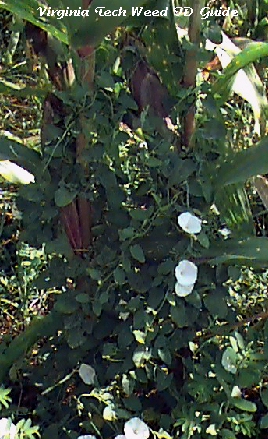 The beliefs in the British Isles surrounding C. arvensis are quite different. In some regions, it is believed that if a woman picks it, her lover will die, giving it the common name of “young man’s death.” In other regions, it is referred to as “thunder flower”, associated with the belief that picking one will cause thunder. It is suggested both of these myths originate as stories told to children to prevent them from entering fields and killing horticultural plants (11).
The beliefs in the British Isles surrounding C. arvensis are quite different. In some regions, it is believed that if a woman picks it, her lover will die, giving it the common name of “young man’s death.” In other regions, it is referred to as “thunder flower”, associated with the belief that picking one will cause thunder. It is suggested both of these myths originate as stories told to children to prevent them from entering fields and killing horticultural plants (11).
C. arvensis also has ethnobotanical history in the New World, probably due to its early introduction. As early as 1890, a United States herbalist described as a laxative. It then entered American Indian medicinal usage: the Navajo use it as a medicine for spider bites and an intestinal stimulant, the Pomo use it to aid menstruation and childbirth, and the leaves and roots are considered to be laxatives in some South American cultures, where a medicine from the leaves is made to stimulate bile flow (4). The stem is also used by the Okanagan-Colville people of the Northwest as a pack-rope for carrying small-game they have hunted (12).
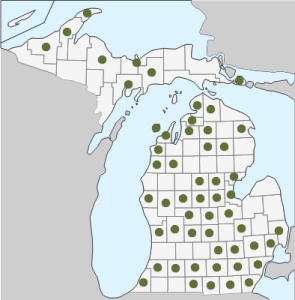 Phylogenetic Information: Convolvulaceae has anywhere between two and ten subfamilies depending on classification. APG III places Convolvulaceae within the Solanales as sister to the Solanaceae. The clade is in Asterids II (14,15) of the angiosperms.
Phylogenetic Information: Convolvulaceae has anywhere between two and ten subfamilies depending on classification. APG III places Convolvulaceae within the Solanales as sister to the Solanaceae. The clade is in Asterids II (14,15) of the angiosperms.
Interesting Quotation or Other Interesting Factoid not inserted above: Common names of C. arvensis from other countries (4): China: tian xuan tian (“heaven flower of field”); England: bear-bind, withwind; France: petit vrille (“small twiner”): Germany: Ackerwinde (“field twiner”), bear-bind; India: chandvel (vel is Marathi for “twiner”); Ireland: ladh-lus (“binding herb”); Israel: havalbal h’sadeh (“field rope”); Italy: trigarella (“entangler”), vellucchio comune (“common tangler”), erba leprina (“hare vine”); Latin America: enradedera europea (“European twiner”), tripa de pollo (“chicken guts”).
Described as “one of the 10 worst weeds in the world” (10). It is also suggested by Austin (4) that C. arvensis was considered a weed in European gardens as early as 1633, and in 1875, it was realized as a weed in America. It has been considered since the late 1800s to be difficult or impossible to eradicate in the United States, and highly detrimental to field crops. Research indicates that fall application of herbicides is far more effective than spring or summer applications in controlling bindweed in wheat fields in Oklahoma (16).
Literature and websites used:
- USDA, NRCS. 2008. The PLANTS Database, Version 3.1, National Plant Data Center, Baton Rouge, LA 70874-4490 USA. http://plants.usda.gov/ <Accessed November 23, 2008.>
- ITIS: Integrated Taxonomic Information System http://www.itis.gov/index.html Retrieved November 23, 2008, from the Integrated Taxonomic Information System on-line database.
- US Forest Service: Invasive Plants Weed of the Week. Convolvulus arvensis. http://www.na.fs.fed.us/fhp/invasive_plants/weeds/field_bindweed.pdf Accessed November 23, 2008.
- Austin, D.F. 2000. Bindweed (Convolvulus arvensis, Convolvulaceae) in North America—from medicine to menace. Bulletin of the Torrey Botanical Club 127(2):172 -177
- The Book of Field and Roadside: Open-Country Weeds, Trees, and Wildflowers of Eastern North America By John Andrew Eastman, John Eastman.
- Zouhar, Kris. 2004. Convolvulus arvensis. Fire Effects Information System, U.S. Department of Agriculture, Forest Service. http://www.fs.fed.us/database/feis/ <Accessed November 23, 2008.
- Tenaglia, D. 2006. Missouri Plants. http://www.missouriplants.com/Whitealt/Convolvulus_arvensis_page.html
- Iverson, L.R., D. Ketzner, & J. Karnes. 1999. Illinois Plant Information Network. Database at http://www.nrs.fs.fed.us/data/il/ilpin/. Illinois Natural History Survey and USDA Forest Service.
- Gianoli, E. 2004. Plasticity of Traits and Correlations in Two Populations of Convolvulus arvensis (Convolvulaceae) Differing in Environmental Heterogeneity. International Journal of Plant Science 165(5): 825-832.
- Invasive Assessment – Field Bindweed (Convolvulus arvensis) in Victoria. Victoria Resources Online. 2008. http://www.dpi.vic.gov.au/dpi/vro/vrosite.nsf/pages/invasive_field_bindweed. <Accessed November 23, 2008.>
- Vickery, R. 1997. A Dictionary of Plant-lore. Oxford, England: Oxford University Press.
- Moerman, D. 2006. Native American Ethnobotany. University of Michigan – Dearborn. http://herb.umd.umich.edu/
- Bailey, H.L. 1963. How Plants Get Their Names. New York, New York, USA: Dover Publications, Inc.
- ANGIOSPERM PHYLOGENY GROUP Stevens, P. F. (2001 onwards). Angiosperm Phylogeny Website. Version 12, July 2012 [and more or less continuously updated since]. http://www.mobot.org/MOBOT/research/APweb/.
- ITIS: Integrated Taxonomic Information System http://www.itis.gov/index.html Retrieved November 23, 2008, from the Integrated Taxonomic Information System on-line database.
- Stone, A.E., T.F. Peeper, & J.P. Kelley 2005. Efficacy and acceptance of herbicides applied for field bindweed (Convulvulus arvensis) control. Weed Technology 19:148–153.
- Tropicos.org. Missouri Botanical Garden. 21 Jun 2014 <http://www.tropicos.org/Name/8500005>
- Michigan Flora Online. A.A. Reznicek, E.G. Voss, & B.S. Walters. February 2011. University of Michigan. Web. June 21, 2014. http://michiganflora.net/family.aspx?id=Convolvulaceae.
- Raju, M.V.S., R.T. Coupland, and T.A. Steeves. 1966. On the occurrence of root buds on perennial plants in Saskatchewan. Canadian Journal of Botany 44: 33-37.
Image Credits (all used with permission):
1) Image of pink/white flower © 1997-2008 David G. Smith at www.delawarewildflowers.org.
2) The image of the leaves © Ohio State Weed Lab Archive, The Ohio State University, Bugwood.org.
3) Image of white flower © 1997-2008 David G. Smith at www.delawarewildflowers.org.
4) The image of the capsules is by © Richard Old, www.xidservices.com.
5) The image of the plant’s habit © Scott Hagood, Virginia Tech
6) Species distribution map, derived from the Michigan Flora Online.
Primary Author: Becca Sonday and John Bradtke, with editing by Robyn J. Burnham
© Robyn J. Burnham, University of Michigan
For additional information on Michigan Plant Diversity web pages please contact Robyn J. Burnham via email: rburnham“at”umich.edu